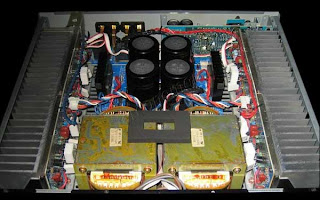MX-1 Mx-2 Power
Amplifier
Top-ART Ensures Top
Quality
Like
the preamplifiers the MX-1 and MX-2 benefit from Yamaha's ToP-ART design
policy. Every single part was carefully considered during their development, so
you can be sure you're purchasing a component with the finest quality
throughout. A number of these parts are particulary noteworthy. They use twin
massive power transformers and twin heavy-duty extruded aluminum heat sinks.
Their block capacitors are extremely large (MX-1 : 36,000 μFx2 and 33,000 μFx2), and all
PC board wiring is extra-thick and gold-plated. To support these heavy
components and prevent vibration, they have a special ART base inside the
chassis. It has a double panel structure, each 1,6 mm thick, and the MX-1 adds
extra damping material between the two panels. If these two amps sound weighty,
they are; try picking one up. But remember, those heavy parts are where the
power comes from.
Huge Power Output
and Low-Impedance Drive Capability
The MX-1 delivers
200 watts per channel of RMS power at 8 ohms, and 250 W at 2 ohms. MX-2 output
is 150 W at 8 ohms and 250 W at 2 ohms. Note that both of these amplifiers are
rated for continuous output power all the way down to 2 ohms - impossibile for
most amplifiers because lower impedances cause much higher amounts of
distortion. This means that these amps can be used with low impedance speakers
and will function flawlessly even under fluctuating loads caused by variations
in the music signal.
Dynamic power
levels, or the ability to deliver momentary power levels beyond the RMS power
rating, are also exceptionally high. 280/610 W (8/2 ohms) for the MX-1 and
190/400 W (8/2 ohms) for the MX-2. This ability is especially important when
playing CDs, which have a very wide dynamic range.
Hyperbolic
Conversion Amplification (HCA)
High performance
amplifiers generally use Class A amplification, but the Yamaha-developed HCA
circuit goes a step beyond conventional Class A. In a Class A amplifier, when
output exceeds a limit determined by the idling current, operation degrades to
Class AB, resulting in increased crossover and switching distortion. HCA
eliminates this problem by obtaining its output form hyperbolic conversion. So
there's less distortion, a wider range of linear operation, and less heat
generation.
Advanced Power
Supply (APS)
An amplifer's power
supply circuitry is one of the critical determinants of its overall
performance. If it does not provide a constant voltage the power transistors
will not be able to perform properly. At low power levels, ordinary power
supplies are adequate, but at middle and high levels, especially at low
impedances, voltage irregularities called ripple are likely to occur. Yamaha's
APS circuitry prevents ripple, maintaining
precisely constant voltage at all power levels.
New Linear Damping
Circuit
The damping factor
of an ampilfier is its ability to stop the speaker cone from vibrating when it
shouldn't, that is when the signal stops. level variations due to high amp
impedance tend to reduce the damping factor, and frequency variations cause it
to fluctuate. This new circuit cancels the effect of these variations,
maintaining an extremely high, stable damping factor (350 at 8 ohms, 20 -20,000
Hz). The result is superior articulation of all sounds and significantly
improved frequebcy response.
Other Notable
Features
L/R level Controls
(on rear panel)
Gold-plated Input
Jacks (MX-1 Jack are Solid Brass)
Extra-Large,
Anti-Vibration Feet
2-Way Binding
Speaker Terminals (Banana Plug Compatible)
MX-1 Specification
Minimum RMS Output
Power per Channel:
200 W
(8 Ω) from 20 to 20,000 Hz at no more
than 0,008% THD
260 W
(4 Ω) from 20 to 20,000 Hz at no more
than 0,03% THD
320 W
(2 Ω) from 20 to 20,000 Hz at no more
than 0,09% THD
Dynamic Power per
Channel (by IHF Dynamic headroom Measuring Method):
280 W at 8 ohms
460 W at 6 ohms
630 W at 2 ohms
Dynamic Headroom :
1,46 dB at 8 ohms
2,48 dB at 6 ohms
2,94 dB at 2 ohms
Power
Bandwidth (8Ω, 0,03% THD, half Rated Power): 10 to 60,000 Hz
Damping Factor
(SPA,
8Ω, 20 - 20,000 Hz) : 350
(8Ω, 1 kHz) : 250
Input
Sensitivity/Impedance (Main IN): 1,46
V/20 kΩ
Frequency Response
(Main In): 20 to 20,000 Hz, ±0,5 dB
Signal-to-Noise
Ratio (IHF-A-Network): 125 dB (Main In,
Shorted)
Residual
Noise (IHF-A-Network): 20 μV
Channel
Separation (Vol -30 dB, Main In, Input 5,1 kΩ terminaled)
1 kHz/10 kHz : 80
dB/ 60 dB
Dimensions (W x H x
D): 438 x 116 x 486 mm (17-1/4 x 4-9/16
x 19-1/8 inch)
Weight: 24,kg (52
lbs, 14 oz)
MX-2 Specification
Minimum RMS Output
Power per Channel:
150 W
(8 Ω) from 20 to 20,000 Hz at no more
than 0,008% THD
190 W
(4 Ω) from 20 to 20,000 Hz at no more
than 0,03% THD
230 W
(2 Ω) from 20 to 20,000 Hz at no more
than 0,09% THD
Dynamic Power per
Channel (by IHF Dynamic headroom Measuring Method):
190 W at 8 ohms
310 W at 6 ohms
410 W at 2 ohms
Dynamic Headroom :
1,03 dB at 8 ohms
2,12 dB at 6 ohms
2,51 dB at 2 ohms
Power
Bandwidth (8Ω, 0,03% THD, half Rated Power): 10 to 60,000 Hz
Damping Factor
(SPA,
8Ω, 20 - 20,000 Hz) : 350
(8Ω, 1 kHz) : 250
Input
Sensitivity/Impedance (Main IN): 1,26
V/20 kΩ
Frequency Response
(Main In): 20 to 20,000 Hz, ±0,5 dB
Signal-to-Noise
Ratio (IHF-A-Network): 123 dB (Main In,
Shorted)
Residual
Noise (IHF-A-Network): 20 μV
Channel
Separation (Vol -30 dB, Main In, Input 5,1 kΩ terminaled)
1 kHz/10 kHz : 80
dB/ 60 dB
Dimensions (W x H x
D): 438 x 116 x 486 mm (17-1/4 x 4-9/16
x 19-1/8 inch)
Weight: 19,5kg (43
lbs)








Nessun commento:
Posta un commento